Freehold (732) 294-9393
Freehold (732) 294-9393
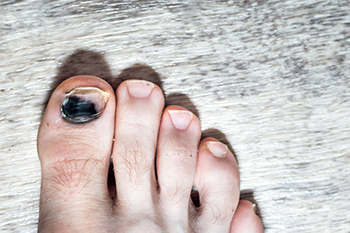
Runner's toe is a condition commonly experienced by runners and those who walk frequently. It occurs when repetitive trauma causes blood to collect beneath the toenail. It results in a blackened nail, known as a subungual hematoma. Wearing tight shoes and constant pressure on the toes during such exercise can lead to this issue. Symptoms of runner's toe include nail discoloration, pain, and occasionally, the nail separating from the nail bed. While a black toenail may heal on its own, it can sometimes lead to complications, such as infection or thickening of the nail. A podiatrist can assess the severity of the blackened toenail and suggest pain relief medication. This foot doctor will also check for underlying issues, such as fungal infections or circulatory problems that may contribute to the condition. If you are a runner with a toenail that has turned black, it is suggested that you visit a podiatrist for an exam and treatment.
Exercising your feet regularly with the proper foot wear is a great way to prevent injuries. If you have any concerns about your feet, contact Dr. Henry Miller of New Jersey. Our doctor will treat your foot and ankle needs.
How to Prevent Running Injuries
Many common running injuries are caused by overuse and overtraining. When the back of the kneecap starts wearing out and starts causing pain in your knee, this is commonly referred to as runner’s knee. Runner’s knee is a decrease in strength in your quadriceps and can occur if you’re not wearing properly fitted or supporting shoes. To prevent runner’s knee, focusing on hip strengthening is a good idea, as well as strengthening your quads to keep the kneecaps aligned.
What Are Some Causes of Running Injuries?
- One cause of a common running injury is called iliotibial band syndrome.
- Plantar fasciitis is also another common injury.
- Stress fractures can occur from overtraining, lack of calcium, or even your running style.
Best Ways to Prevent Running Injuries
- Wear footwear that fits properly and suits your running needs.
- Running shoes are the only protective gear that runners have to safeguard them from injury.
- Make a training schedule. Adding strengthening exercises as well as regular stretching can help keep you strong and limber and can lessen the possibility of injuries.
- Stretching keeps muscles limber; this will help you gain better flexibility.
If you have any questions please feel free to contact our office located in Freehold, NJ . We offer the newest diagnostic and treatment technologies for all your foot and ankle needs.
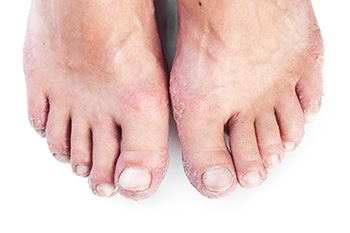
Psoriatic arthritis, or PsA, is a type of inflammatory arthritis that affects some people who have psoriasis. It can cause significant pain and swelling in the feet. When PsA targets the feet, it commonly affects the small joints in the toes. This leads to a condition called dactylitis, or sausage toe, where the entire toe swells up. It can also cause enthesitis, which is inflammation where tendons and ligaments attach to bones, often at the heel or arch. This inflammation can make walking difficult and lead to structural changes in the foot over time. A podiatrist can provide valuable support for treating psoriatic arthritis in the feet by prescribing custom orthotics, and anti-inflammatory therapies, as well as offering guidance on proper footwear to relieve pressure on affected areas. If untreated, PsA in the feet can progress to deformities, making early intervention important. If you have psoriatic arthritis that affects your feet, it is suggested that you schedule an appointment with a podiatrist for an exam and relief options.
When dealing with systemic disease of the feet, it is extremely important to check the affected areas routinely so that any additional problems are caught quickly. If you have any concerns about your feet and ankles contact Dr. Henry Miller from New Jersey. Our doctor will assist you with all of your podiatric needs.
Systemic Diseases of the Feet
Systemic diseases affect the whole body, and symptoms usually are displayed in the feet. This condition can make a patient’s ability to walk unbearable. Systemic diseases include gout, diabetes mellitus, neurological disorders, and arthritis.
Gout – is caused by an excess of uric acid in the body. Common symptoms include pain, inflammation, and redness at the metatarsal/phalangeal joint of the base big toe. Gout can be treated by NSAIDs to relieve pain and inflammation, and other drugs that lower the acid levels in the body.
Diabetes mellitus – is an increase in the level of blood sugar that the body cannot counteract with its own insulin. Failure to produce enough insulin is a factor in Diabetes.
Diabetes of the Feet
Diabetic Neuropathy – may lead to damaged nerves and affect the feet through numbness and loss of sensation.
Peripheral Vascular Disease – can restrict the blood flow to the feet, and often times lead to amputation of the feet.
If you have any questions please feel free to contact our office located in Freehold, NJ . We offer the newest diagnostic and treatment technologies for all your foot and ankle needs.
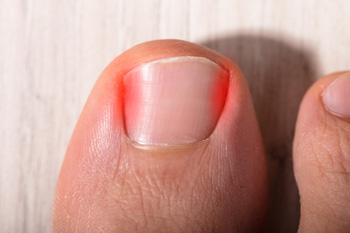
Ingrown toenails occur when the edge of a toenail grows into the surrounding skin, causing pain and discomfort. Common symptoms include redness, swelling, and tenderness at the affected site, often accompanied by pus or drainage if an infection develops. Several factors can contribute to ingrown toenails, including improper nail trimming, wearing tight footwear, or having naturally curved nails. Trauma to the toe, such as stubbing, can also increase the risk. Diagnosis typically involves a physical examination by a podiatrist who assesses the nail and surrounding tissue. In some cases, imaging may be used to rule out other conditions. If you have a problematic ingrown toenail, it is suggested that you seek treatment from a podiatrist.
Ingrown toenails may initially present themselves as a minor discomfort, but they may progress into an infection in the skin without proper treatment. For more information about ingrown toenails, contact Dr. Henry Miller of New Jersey. Our doctor can provide the care you need to keep you pain-free and on your feet.
Ingrown Toenails
Ingrown toenails are caused when the corner or side of a toenail grows into the soft flesh surrounding it. They often result in redness, swelling, pain, and in some cases, infection. This condition typically affects the big toe and may recur if it is not treated properly.
Causes
You are more likely to develop an ingrown toenail if you are obese, have diabetes, arthritis, or have any fungal infection in your nails. Additionally, people who have foot or toe deformities are at a higher risk of developing an ingrown toenail.
Symptoms
Some symptoms of ingrown toenails are redness, swelling, and pain. In rare cases, there may be a yellowish drainage coming from the nail.
Treatment
Ignoring an ingrown toenail can have serious complications. Infections of the nail border can progress to a deeper soft-tissue infection, which can then turn into a bone infection. You should always speak with your podiatrist if you suspect you have an ingrown toenail, especially if you have diabetes or poor circulation.
If you have any questions, please feel free to contact our office located in Freehold, NJ . We offer the newest diagnostic and treatment technologies for all your foot care needs.
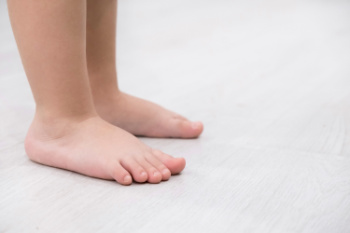
Flat feet, or pes planus, occur when a child’s feet lack a noticeable arch, causing the entire foot to touch the ground. While babies and toddlers naturally have flat feet, most develop arches as they grow. However, in some cases, the arch never forms. Signs of flat feet include feet with no visible arch and, in some cases, discomfort or pain in the feet, ankles, or knees. Flat feet can result from having tight Achilles tendons, muscle imbalances, or irregular bone formation. Additionally, certain genetic disorders, like Down syndrome or osteogenesis imperfecta, can contribute to flat feet. Sometimes, the condition runs in families. If you notice signs of flat feet in your child and they seem to be experiencing pain or discomfort, it is a good idea to seek advice from a podiatrist. They can offer guidance on managing the condition and help ensure your child’s feet stay healthy and pain-free.
The health of a child’s feet is vital to their overall well-being. If you have any questions regarding foot health, contact Dr. Henry Miller of New Jersey. Our doctor can provide the care you need to keep you pain-free and on your feet.
Tips for Keeping Children's Feet Healthy
If you have any questions, please feel free to contact our office located in Freehold, NJ . We offer the newest diagnostic and treatment technologies for all your foot care needs.
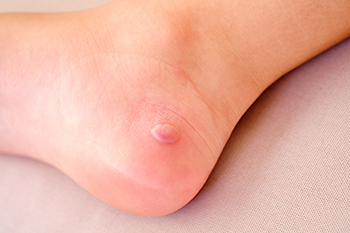
A friction blister on the foot is a small, fluid-filled bubble that forms on the skin due to repeated friction or rubbing. This common condition typically occurs in areas where the skin is subjected to constant pressure, such as the heels or the balls of the feet. The primary cause is prolonged or intense friction from wearing poorly fitting shoes, new footwear, or excessive physical activity. Moisture from sweat can worsen the problem by softening the skin, making it more susceptible to blisters. Wearing proper footwear and moisture-wicking socks can help reduce the risk of developing friction blisters. If you have developed a foot blister that has become infected, it is strongly suggested that you contact a podiatrist who can treat this condition and offer effective prevention tips.
Blisters may appear as a single bubble or in a cluster. They can cause a lot of pain and may be filled with pus, blood, or watery serum. If your feet are hurting, contact Dr. Henry Miller of New Jersey. Our doctor can provide the care you need to keep you pain-free and on your feet.
Foot Blisters
Foot blisters are often the result of friction. This happens due to the constant rubbing from shoes, which can lead to pain.
What Are Foot Blisters?
A foot blister is a small fluid-filled pocket that forms on the upper-most layer of the skin. Blisters are filled with clear fluid and can lead to blood drainage or pus if the area becomes infected.
Symptoms
(Blister symptoms may vary depending on what is causing them)
Prevention & Treatment
In order to prevent blisters, you should be sure to wear comfortable shoes with socks that cushion your feet and absorb sweat. Breaking a blister open may increase your chances of developing an infection. However, if your blister breaks, you should wash the area with soap and water immediately and then apply a bandage to the affected area. If your blisters cause severe pain it is important that you call your podiatrist right away.
If you have any questions, please feel free to contact our office located in Freehold, NJ . We offer the newest diagnostic and treatment technologies for all your foot care needs.